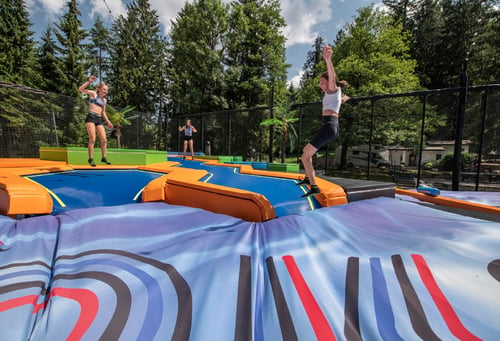Trampoline parks are growing in popularity worldwide, but as with any physical activity, there are risks involved. Building these parks to specific safety standards is essential for protecting users and owners from potential injuries and liability. Make sure you know the safety standards first for a worry-free experience.
The importance of building Trampoline parks according to standards,
for the safety of users
Trampoline parks consist of different modules, ranging from easy to challenging, which can potentially cause injuries. To ensure the safety of all users, various standards have been established based on years of experience and best practices. Manufacturers and operators of Trampoline parks utilize these standards to identify and eliminate potential hazards that could harm users. The park needs to meet these safety standards to provide a safe environment for families to enjoy.
 Why building Trampoline parks according to standards is essential for owners
Why building Trampoline parks according to standards is essential for owners
Building a Trampoline park is a huge investment, and the last thing any owner wants is to be hit with a lawsuit because of an injury. That's why it's crucial to follow the latest safety standards and guidelines. By doing so, owners can minimize the risk of accidents and protect themselves from liability.
When someone is injured at a Trampoline park, liability will be investigated. If the park was built to the required standards and certified by an accredited body, this in the ais of low means that the owner has taken all necessary precautions to prevent injuries. It's a clear sign of due diligence and responsibility. On the other hand, if the park was not built to the required standards, this is an indication of negligence on the owner's part, and they will be held responsible for any injuries that occur.
In addition to minimizing the risk of accidents and lawsuits, building a Trampoline park according to the latest standards and guidelines can also lead to lower insurance premiums. Insurance companies view certified parks as lower risk and therefore offer more competitive rates. By investing in safety, owners can not only protect themselves and their customers but also save money in the long run.
Importance of designing and building the Trampoline park by standards for specifics elements
Building Trampoline parks with modules such as foam pits, airbags, and high-performance areas offer unique experiences to users, but they also pose potential safety hazards. To mitigate these risks, standards require that they meet specific safety requirements.
1. Foam pits and airbags
-
Foam pits and airbags are popular attractions at Trampoline parks, offering users a unique and thrilling experience. However, these modules also pose a potential safety risk, and it's crucial to adhere to industry standards to minimize those risks.
- To ensure safety, standards dictate that access to the foam pit or airbag must be from only one direction. Users cannot jump into the foam pit or airbag from any side, but only one, and the exit must be on the opposite side to prevent users from crossing paths with each other, which can cause injury or death.
- In addition, the foam pit or airbag must be at least 1.5 meters wider than the trampolines or jumping areas on each side. This provides a safety zone where jumpers can land if they are carried away during a jump and land too far left or right. If the foam pit or airbag is too narrow or as wide as the jumping areas, the jumper can fall off the edge and sustain an injury.
By following these standards, Trampoline park operators can provide users with a safe and enjoyable experience while minimizing the risk of injury.
2. High-performance area (HP area)
High-performance trampolines are designed for advanced jumping, which means that not every jumper is allowed to access them without professional supervision.
- Standards require that the HP area of the Trampoline park is spatially and visually separated from other modules. The HP area must not be in direct contact with other trampolines or modules and must be secured with a safety net.
- In addition, the area around the HP trampoline must be padded with special soft cushions capable of absorbing landings from higher heights, with a minimum width of 2 meters.
- Furthermore, the walls for Walk-the-wall must meet certain height requirements, and the HP area must be painted in a different color from the rest of the Trampoline park to ensure clear visual separation. Given that HP trampolines are very bouncy, the risk of injury is higher, and therefore special safety measures and supervision are required.
Apart from these key elements, other standard requirements must be followed when building a Trampoline park. These include:
- the height and number of trampolines allowed in a specific area,
- the use of safety padding and nets,
- the number and location of staff members to ensure that jumpers are following safety rules, and
- the regular inspection and maintenance of equipment.
Building a Trampoline park to standards is crucial for the safety of users, owners, and the longevity of the park. By following industry standards and guidelines, owners can provide a safe and enjoyable experience for customers while minimizing the risk of accidents and lawsuits.



